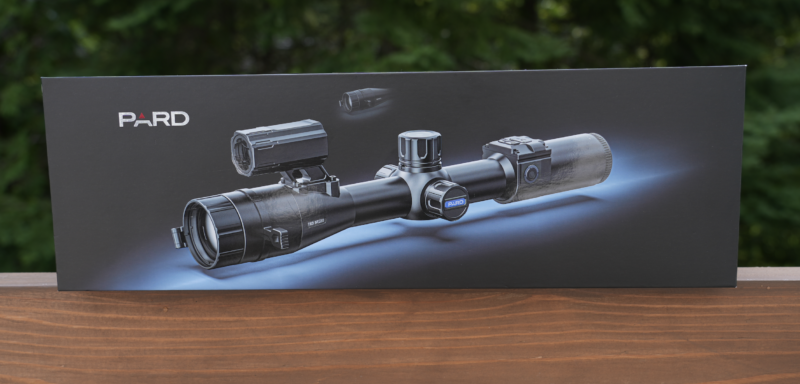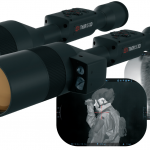The Pard TS36(LRF) Thermal Scope Delivered Beyond my Expectations

1. Lens
PARD currently sells two variations of the TS Scope, the TS36 and TS34. For both of these variants, you have the options of a 19mm(TS34 only), 25mm, 35mm, or 45mm lens delivering wider and more narrow fields of view. Where the main decision plays out is what you plan to hunt and the distance you will need to acquire targets. With a smaller objective lens, you will be able to see farther and vice versa.
Imagine you’re looking through a thermal scope like you’re peering through a window. The field of view is how much you can see through that window. If you have a smaller field of view, it means you’re zoomed in more, almost like using binoculars or a camera with a telephoto lens.
So, when you’re hunting and you’ve got a thermal scope with a smaller field of view, it’s like having a powerful zoom. This zoom lets you focus on a smaller area in the distance, and objects appear bigger and clearer. This is great for spotting targets that are far away.
2. High Sensitivity 12µm LWIR Sensor
When looking at almost any thermal device on the market, it can be hard to decode what some of the finer and more technical components are. In this case, the TS36(LRF) Thermal Scope features a High Sensitivity 12µm LWIR Sensor with 640*480 pixel 12μm vanadium oxide (VOx) sensor, NETD ≤25mK and 12µm pixel. So, what exactly does that mean? I’ll break it down for you!
- 640×480 Pixel Resolution: This refers to the number of individual pixels in the sensor array. In this case, there are 640 pixels in the horizontal direction and 480 pixels in the vertical direction. These pixels work together to form the image captured by the thermal sensor.
- 12μm Vanadium Oxide (VOx) Sensor: This refers to the material and size of the individual sensing elements in the array. The sensor uses vanadium oxide (VOx) as the material to detect thermal radiation. The “12μm” indicates the size of each pixel, with “μm” standing for micrometers. This pixel size determines how small a detail the sensor can capture.
- NETD ≤25mK: NETD stands for Noise Equivalent Temperature Difference. It’s a measure of the smallest temperature difference that the sensor can detect in the presence of noise. Lower NETD values indicate better sensitivity. In this case, the sensor has a NETD of ≤25 milliKelvin (mK), which means it can detect very small temperature differences as low as 25 mK.
- 12µm Pixel Pitch: The pixel pitch is the distance between the centers of two adjacent pixels. In this case, it’s 12 micrometers. Smaller pixel pitch generally means higher resolution, but it can also impact the sensor’s ability to capture more detailed information.
In less complex terms:
- The sensor has a resolution of 640×480 pixels, which means it can capture images with 640 pixels in width and 480 pixels in height.
- The sensor uses vanadium oxide (VOx) as the material for its pixels, with each pixel having a size of 12 micrometers.
- The sensor has a high sensitivity, with a NETD of ≤25 mK. This means it can detect very small temperature differences, making it suitable for spotting even subtle heat variations.
- The pixel pitch of 12 micrometers indicates that the sensor’s pixels are relatively close together, potentially allowing for higher detail in captured images.
3. 800*800 IPS Ultra-clear Display
As I mentioned earlier in this article, the 800×800 circular display absolutely stole the show. Having used many other thermal scopes over the years, I never really noticed how unnatural a rectangular display is. That is, until I first peered through the PARD TS36(LRF). Not only is the display crystal clear, but it mimics the already familiar circular design of every other traditional scope you are likely using. The design of the display provided me with a very comfortable experience and also the perception that I had more to look at.
PARD did are really great job at integrating the display features utilizing the circular design.They were able to comfortably fit status icons for battery, wi-fi, paired devices, bearing, time, zoom, yardage, windage, ballistic calculation, and thermal palette all around the edge of the display. It may seem like too much for a single view, however, it all fits comfortably and does not detract from the shooters experience.

4. Color Palettes & Scenes
The PARD TS36(LRF) gives you 6 color palette options including white hot, black hot, edge, red hot, in hot, and sky. When taking the photos you see above I used a steel plate which I heated up using an off the shelf propane torch. What I found to be incredibly impressive was the fact that I purposefully did not heat the plate up to extreme temperatures. What you see above is a steel plate that is only slightly above room temperature.

I also found the edge thermal display to be incredibly cool. I have never seen or used another thermal device that has this palette and the contrast it provides is really impressive.
Outside of the color pallets, you have three scene settings which include city, rain, and forest. These are similar to your cell phones preset filters and will adjust your display settings to better suit your environment beyond how the thermal palette displays.
What I found to be very convenient was that the TS36(LRF) had well placed physical buttons that cycle through all of the color palettes so that you don’t need to dive in to the digital display to adjust visuals. With one button, you can cycle through all six thermal palettes in just a few seconds.
5. Image & Video Capture
Like most of the thermals on the market, the PARD TS36(LRF) includes built in image and video capture that is stored on a microSD card that can be up to 128GB. The scope has a dedicated physical button for image/video capture which is easy to use and functioned very well. You simply long press the video button to begin recording and then single tap the same button during a video recording to also capture still images on the fly. If you find yourself getting tunnel vision when preparing to shoot, you can also leverage the self-activated recording feature which will activate when the scope detects recoil.
PARD also has a smartphone application which can be leveraged as a DVR for recording and sharing media over the scopes wi-fi signal.
Final Impressions
The PARD TS36 LRF thermal imaging scope stands out as a remarkable addition to the thermal imaging landscape. It’s lightweight build, circular display, and the company’s track record make it a compelling choice for hunters seeking a reliable and user-friendly tool.
PARD is going to be a major player in the U.S. thermal space and I expect to start seeing these scopes pop-up all over the web as hunters begin to convert. The ease of use and superior functionality of the scopes will make PARD a formidable player in the thermal and night vision hunting world.
In my view, this scope is a game-changer that’s poised to elevate hunting experiences to new heights.
How long does the battery last?
The TS series of scopes from PARD use a 18650 Li-ion Battery which will last up to 5 hours, depending on usage.
You can also leverage an external battery bank with compatible USB ports to extend the battery life.
Is the TS36(LRF) Wetherproof?
The TS36(LRF) is waterproof and IP67 rated.
Does the TS36(LRF) offer reticle options?
The TS36(LRF) offers 6 different reticle styles and 4 different reticle colors.
What type of connection ports does the TS(36LRF) offer?
HDMI output
USB Type C Power supply
Does the TS36(LRF) connect to external devices?
Yes!
Having built-in WiFi on this device lets you link up with your phone, computer, or tablet. It’s like having an extra screen to see what your device sees. Plus, you can easily send pictures and videos wherever you are, right on the spot.
What is the maximum detection range?
This device can spot targets from as far as 1200 yards away. The recently developed compact ranging module is accurate and speedy in detecting distances. When combined with integrated ballistics, this Long-Range Finder (LRF) equips you with essential range details for nighttime hunting, allowing you to make more informed decisions.
Does the TS36(LRF) have ballistic calculation?
Yes!
By harnessing the power of an integrated ballistic calculator, this scope quickly computes essential bullet trajectory data – factors like velocity, bullet weight, and zero range. The result is a substantial enhancement in accuracy, as it crafts pinpointed aiming references for your subsequent shot placements.
We are committed to finding, researching, and recommending the best products. We earn commissions from purchases you make using the retail links in our product reviews. Learn more about how this works.















